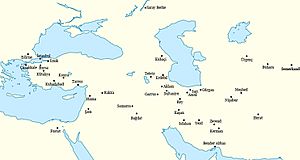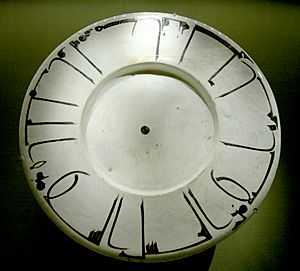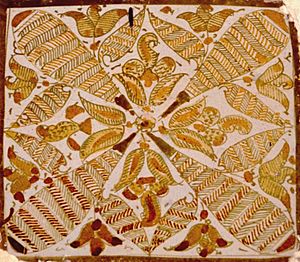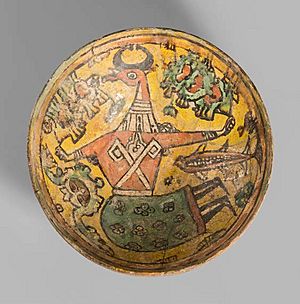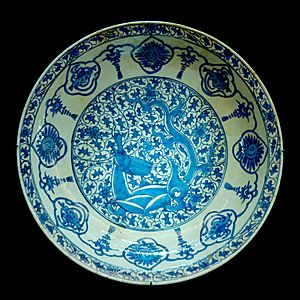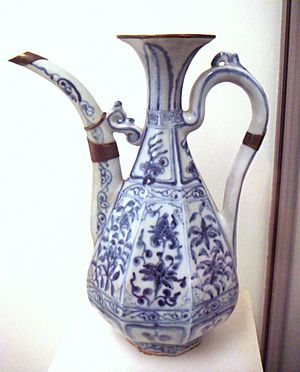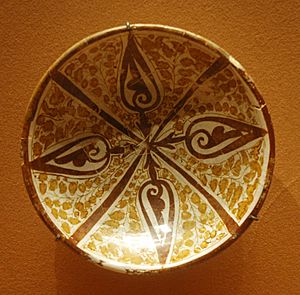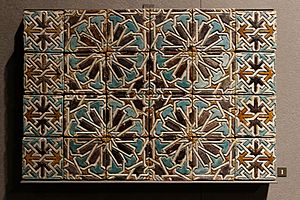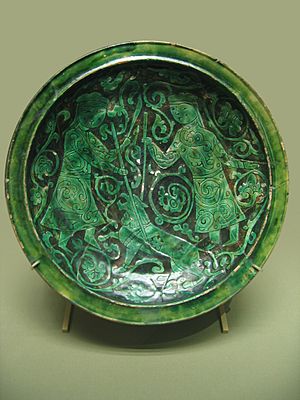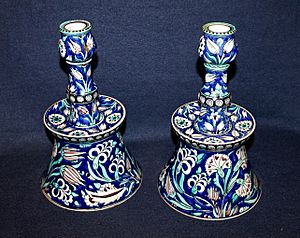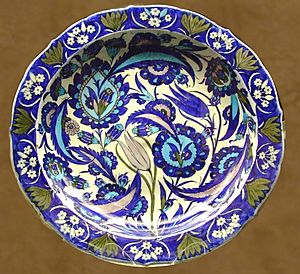Islamic pottery facts for kids
Islamic pottery refers to the beautiful and unique pottery made in the Muslim world during the Middle Ages. This pottery was created in a large area, from Spain in the west to Central Asia in the east. It was influenced by amazing Chinese ceramics but also inspired pottery in Europe and the Byzantine Empire.
Unlike in Europe, where rich people often used gold and silver dishes, Islamic teachings discouraged this. So, wealthy Muslims used pottery and glass for their meals. This helped pottery making become a very important art form. Islamic artists also used pottery to decorate buildings with amazing geometric designs and plant patterns, which became a special part of Islamic art.
The story of Islamic pottery began around the year 622. From 633, Muslim armies quickly moved into places like Persia, Byzantium, Mesopotamia, Anatolia, and Egypt. It's a bit hard to know much about the very first Islamic pottery because not many pieces from that time have survived. However, many decorative tiles used on buildings and mosques did last.
The Muslim world already had skilled potters in places like Mesopotamia, Persia, and Egypt. These areas had a long history of making pottery, even dating back to ancient Egypt. But under Islam, artists started using fewer human or animal figures. Instead, they focused on developing beautiful geometric and plant-based designs. They also became experts at creating large decorative patterns using many tiles.
Contents
Early Islamic Pottery (622–1200)
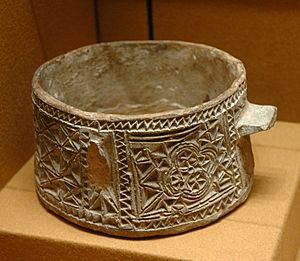
A special Muslim pottery style really started to appear in the 9th century in Iraq, Syria, and Persia. During this time, potters often used white tin-glaze to make their pieces shiny and opaque. We don't have much information about pottery from earlier periods. This is because not many pieces survived in good condition.
In the eastern part of the Muslim world, a pottery center grew in Samarkand under the Samanid rulers (874-999 AD). This center was famous for using calligraphy (beautiful writing) in its pottery designs. Pottery from eastern Persia, made between the 9th and 11th centuries, often featured only stylish writing. This style, called "epigraphic ware," is considered some of the most beautiful Persian pottery.
How China Influenced Islamic Pottery
During the Abbasid dynasty, pottery making became very important. Many pieces used opaque white glazes. Some historians believe that this growth was due to influence from China. Old Muslim writings show that trade with China was well established. For example, a governor once sent 20 pieces of special Chinese porcelain to the Caliph (ruler) Harun al-Rashid.
Historians think Chinese pottery influenced Islamic pottery in three main ways. The first contact happened in 751 when Arabs fought the Chinese at the Battle of Talas. Some say that captured Chinese potters might have taught Muslims new pottery skills. By the 800s, Chinese stoneware and porcelain were reaching the Abbasid lands.
The second phase of influence happened in the 12th and 13th centuries. This was a time when the pottery industry was struggling after the fall of the Seljuk dynasty. However, the Mongol invasion brought even more Chinese pottery traditions.
You can see the influence of Chinese pottery from the Tang dynasty in the shiny lustreware made by potters in Mesopotamia. You can also see it in some early white pottery found in Samarra (modern-day Iraq). Similar ceramics were found in Nishapur (Iran) and Samarkand (Uzbekistan).
By the time the Mongols invaded China, a lot of Chinese pottery was being sent to the Islamic world. In the 12th century, Islamic potters tried to copy Chinese porcelain using their own fritware materials. They weren't as successful as Korean potters, but they still made beautiful local pottery that competed with Chinese imports.
The Islamic market was very important for early Chinese blue and white porcelain. This type of porcelain was mostly exported until the Ming dynasty. Large dishes were a popular export item. The detailed designs on Yuan blue and white porcelain often borrowed from Islamic patterns, like arabesques and plant scrolls. These designs probably came from Islamic metalwork. The cobalt blue color used for this porcelain actually came from Persia. Muslim merchants in Chinese ports like Quanzhou helped with this trade.
When the Ming dynasty began in China, a rule was made in 1368 to stop trade with other countries. This rule wasn't completely successful, but it did encourage the Islamic world to make its own pottery in Chinese styles. By then, Islamic pottery was becoming very high quality.
Islamic potters often copied older Chinese styles from the late Yuan and early Ming periods. Later, in the early 16th century, Chinese potters started making some items in Islamic styles, even including Arabic writing. These were likely made for the growing Chinese Muslim community.
Islamic Innovations in Pottery
From the 8th to the 18th centuries, glazed ceramics were very common in Islamic art. Tin-glazing was one of the first new techniques developed by Islamic potters. The first Islamic opaque glazes, often blue, were found in Basra around the 8th century. Another important invention was stoneware, which started in 9th-century Iraq. This was a strong, fine ceramic. Other places known for new pottery ideas included Fustat (Egypt), Damascus (Syria), and Tabriz (Iran).
Lusterware, which has a shiny, metallic surface, was first made in Mesopotamia in the 9th century. This technique quickly became popular in Persia and Syria. Later, it was made in Egypt during the Fatimid rule (10th-12th centuries). While some lusterware continued to be made in the Middle East, it also spread to Europe. It was used in Hispano-Moresque ware in Spain and later in Italian maiolica.
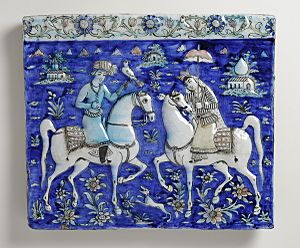
Another invention was the albarello. This is a type of earthenware jar originally used by pharmacists to hold medicines. This jar style came from the Islamic Middle East. The first Italian versions were made in Florence in the 15th century.
Fritware is a type of pottery first made in the Near East. It uses a special ingredient called "frit." A recipe from around 1300 AD describes fritware as having quartz, "frit-glass," and white clay. Adding glass helped the clay become harder and denser at lower firing temperatures.
Middle Islamic Pottery (1200–1400)
By this time, the unique Islamic tradition of decorated wall tiles became very important. These tiles continued to develop alongside pottery vessels. For example, a ruler once sent a potter from Baghdad to Kairouan to make shiny tiles for the mihrab (prayer niche) of the Great Mosque there.
When the Fatimid rule ended in 1171, pottery making moved to new centers. Persia became a major center for pottery under the Seljuk rulers (1038–1327). The Seljuks expanded their rule over many areas that had old pottery traditions.
The Seljuks brought new ideas to the Muslim world, attracting artists and potters from all over. They continued making refined tin and luster glaze ceramics. The Seljuks in Persia also introduced a new type of pottery sometimes called "Faience." This was made from a hard, white paste covered with a clear glaze.
Hispano-Moresque ware appeared in Al-Andaluz (Islamic Spain) in the 13th century. Potters likely moved there after the Fatimid rule ended. This pottery brought lusterware to Europe and was widely sold to Christian kingdoms. The first center was Málaga. Later, Muslim potters moved to the Christian city of Valencia. Suburbs like Manises became important centers, making pottery for Christian markets.
A rare manuscript from 1301 describes how faience was made. It involved powdered quartz, clay, and a glaze mixture. Adding more clay made it easier to shape the faience on a potter's wheel. The glaze itself was made from quartz and plant ashes, which helped the quartz melt at a lower temperature. This new material allowed potters to make more refined designs and a wider variety of items, like bowls, jugs, and tiles.
One example of fritware is Lajvardina-type ceramics, made under the Ilkhanids. These are known for their dark blue underglazes and patterned decorations.
Carved decoration, called sgraffito, is an old technique in Islamic pottery. It involves scratching a design through a white clay coating to show the red clay underneath. Then, the piece is covered with glaze.
The Seljuks also developed "silhouette wares," which have a black background. This was done by coating the white fritware with a thick black clay. The design was then carved out, and a clear or colored glaze was added.
Later Islamic Pottery (1400–onward)
The influence of Blue and white porcelain from the Chinese Yuan dynasty and Ming dynasty can be seen in many ceramics made by Muslim potters. İznik pottery, made near İznik in Anatolia, was supported by the Ottoman court. It produced the finest Ottoman pottery and tiles. These pieces used bold and elegant flower designs, also inspired by Chinese art. A special bright red color was developed for İznik ware.
İznik pottery greatly influenced European decorative arts, like Italian Maiolica. This pottery was made from the 15th century AD, and its best period lasted until the late 16th century. It was made of a special "quartz-frit" material, which included lead oxide to help the ceramic expand less when heated.
The 15th century was the best time for Hispano-Moresque ware from Valencia, Spain. This pottery was made by mostly Muslim potters in a Christian kingdom. Persian pottery under the Safavid dynasty (from 1502) was also heavily influenced by Chinese blue and white porcelain.
The Islamic parts of Southeast Asia, like modern Indonesia and Malaysia, were important markets for Chinese and later Japanese pottery. European trading companies, especially the Dutch East India Company, helped with this trade. Special types of pottery were made for these markets, often large dishes for sharing food.
The medieval Islamic world never developed its own porcelain, but it loved imported porcelain. First, Chinese porcelain, then Japanese porcelain in the 17th century, and later European porcelain in the 18th century. European factories, like those in Vienna, sent many pieces to the Ottoman Empire. Local Islamic pottery factories couldn't compete with these imports. So, local production became more of a craft, repeating traditional patterns.
Studying Islamic Pottery
Arthur Lane wrote two important books that helped people understand the history and value of Muslim ceramics. His first book looked at early ceramics from the Abbasid period to the Seljuk times. His second book focused on later periods, from the Mongols to 19th-century İznik and Persian pottery.
After Lane's work, many other studies appeared. Important works by R.L. Hobson, Ernst J. Grube, Richard Ettinghausen, Alan Caiger-Smith, and Gesa Febervari gave a general overview. Other experts, like Georges Marcais (North Africa), Oliver Watson (Persia), and J.R. Hallett (Abbasid Pottery), focused on specific times or regions.
See also
 In Spanish: Cerámica islámica para niños
In Spanish: Cerámica islámica para niños
- İznik pottery
- Kiln
- Persian pottery
- Dish with epigraphic decoration



